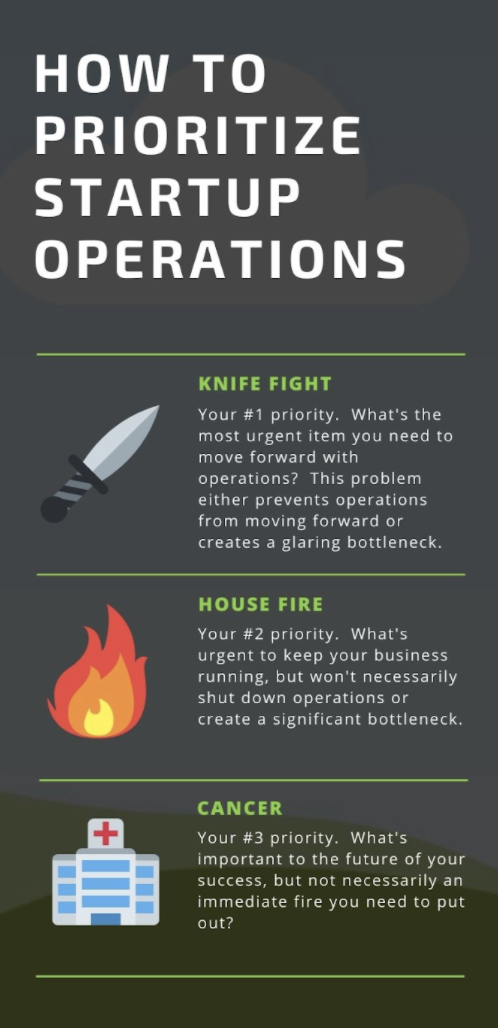Tips to Finding and Vetting Co-Founders
Perhaps the most pivotal building block for every startup exists on the foundation of its team. If you have a great idea or you are in the early...
2 min read
 Logan Burchett
August 28, 2020
Logan Burchett
August 28, 2020
You’ve got three big problems in front of you. A knife fight, a house fire, and cancer. Which problem do you tackle first? And be careful, because if you choose the wrong one, you die. Literally.
Jason Seats, a managing director at Techstars in 2015, shared this time management analogy with our own CEO, Steven Plappert. In the startup world, founders deal with problems not regularly, but constantly. Usually the problems aren’t life or death, but a series of poorly strategized or executed decisions could run our team into the ground. We’re trying to turn an idea in our brains into a profitable business. And nothing ever goes according to plan. While time management creates a daily battle, perhaps one we frequently lose, founders must develop a consistent strategy for prioritization.
As we grow and deeply understand our business, we begin to more intuitively know which problems truly require immediate solutions, and which tasks belong to our long-term vision. Here at Forecastr, we often use Jason Seat’s knife fight, house fire, cancer strategy to identify priorities and map out execution timelines.

I’m no professional on the matter, but you could probably last a few minutes in a house fire. A knife fight, on the other hand, I need to deescalate immediately. With a knife coming at me, I have seconds to escape.
The knife fight is your highest urgency action item. For example, in our early stage startup, Forecastr needs to gain stability in our core application to get our business off the ground. Until we build out the functionality of our core product, brand building and long-term strategy adds minimal value. We identified our number one priority; then we executed the action items to achieve.
If we fail to execute on the knife fight, we will suffocate, and possibly terminate, growth.
Now that I saved myself from the knife fight, I have only minutes to outrun the house fire.
The house fire constitutes an operational bottleneck that will decelerate progress without terminating growth entirely – for now. For example, we needed to raise a round of funding to grow the company. However, we need that core product from the knife fight to secure confident investors. In this instance, fundraising represented an urgent challenge, but more toward our overall growth than the immediate milestone we required for cash flow and credibility.
Now that I survived both a knife fight and a house fire, I have months, or even years, to treat my cancer. If I do not address my cancer, I will not survive. However, the cancer will require a much longer timeline and additional resources to diagnose, treat, and heal.
In the same way, cancer represents opportunities in your business that contribute toward long term vision. For example, Forecastr strives to build the world’s first artificial intelligence CFO. However, we need to build a functioning software and develop our brand before engineering our system toward a 3-5 year goal. We need our core product, a round of fundraising, and probably several more repetitions of this before diving deep into action items behind that reality. Certainly, every step we take tracks in that direction as we pursue our long-term strategy. However, we must prioritize action items to incrementally hit our growing objectives and key results, rather than leap for an ambiguous target without solid foundation.
Apply the knife fight, house fire, cancer approach to your financial model to identify clear targets for quarterly growth and track progress with your team. Create a strategy within your metrics to address each milestone.
1.) Knife Fight – Build a core, stable app
Forecast this strategy and how you’ll acquire beta testers within the growth channels. Identify target numbers each month and adjust sales and marketing to hit the goal.
2.) House Fire – Achieve next round of funding
Indicate specific amounts to raise within your capitalization plan. Forecast when you need to close the round to sustain cash.
3.) Cancer – Become the world’s first AI CFO
Identify downstream product features to monetize in the future. Let your forecast showcase how you plan to upsell your customers and grow revenue with new functionality that the market will love.
Use this analogy to set business priorities within your financial model and track monthly progress with your team to improve short-term execution and sustain long-term vision.
Get notified about new events, free resources, and fresh content

Perhaps the most pivotal building block for every startup exists on the foundation of its team. If you have a great idea or you are in the early...

A financial model can make or break your fundraise. Your model is the backbone of data behind what is otherwise a well-rehearsed pitch for a cool...

Here at Forecastr, we constantly preach the importance of understanding your growth metrics to forecast the future. Marketing analytics provide...